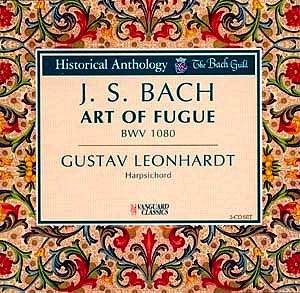Gustav Leonhardt has made several recordings of the
Bach’s Art of Fugue, and took a revolutionary approach to the work,
being the first to maintain (through a pamphlet published in the 1950s)
that it was definitely written for the keyboard, and for just one keyboard
at that. This recording, made in 1953, was his first, and marks a special
point in the history of "authentic" performances of baroque
music.
This recording is interesting, but, like Leonhardt’s
first recording of the Goldberg Variations, also available from Vanguard,
is marred by a harpsichord whose sound is so tinny, so lacking in depth
and relief that it is difficult to listen to. In particular, the lower
range of this harpsichord is terrible, and the fugues and canons using
this part of the instrument sound hollow. Part of this is because of
the recording techniques of the 1950s, but part is simple that the instrument
was not that good. A great deal of progress has been made since, and
one no longer hears this type of sound.
Nevertheless, Leonhardt shows here a deep understanding
of this work, and succeeds far more than in his first Goldberg Variations.
His tempi are a bit slow, as in the Goldbergs, but they sound much better
with such a contrapuntal work as this. At times, as in the fourth part
of the work (listed here as Simple Fugue - theme inverted), it sounds
far too slow to work as music. It takes on the character of a purely
didactic work, an idea that Leonhardt strove to counter in his work.
The harpsichord sounds out of tune in the final, unfinished fugue, and
this makes this masterwork very difficult to listen to.
Leonhardt here, at age 25, showed his courage and audacity,
yet his performance was not up to his ideas. He recognized this by re-recording
the work, and his later Teldec set is far better. While this recording
has historical value, the casual listener, looking for a harpsichord
version of the Art of Fugue, would do better with Davitt Moroney’s recording
on Harmonia Mundi or Robert Hill’s set on Brilliant Classics.
Kirk McElhearn



 Gustav Leonhardt, harpsichord
Gustav Leonhardt, harpsichord